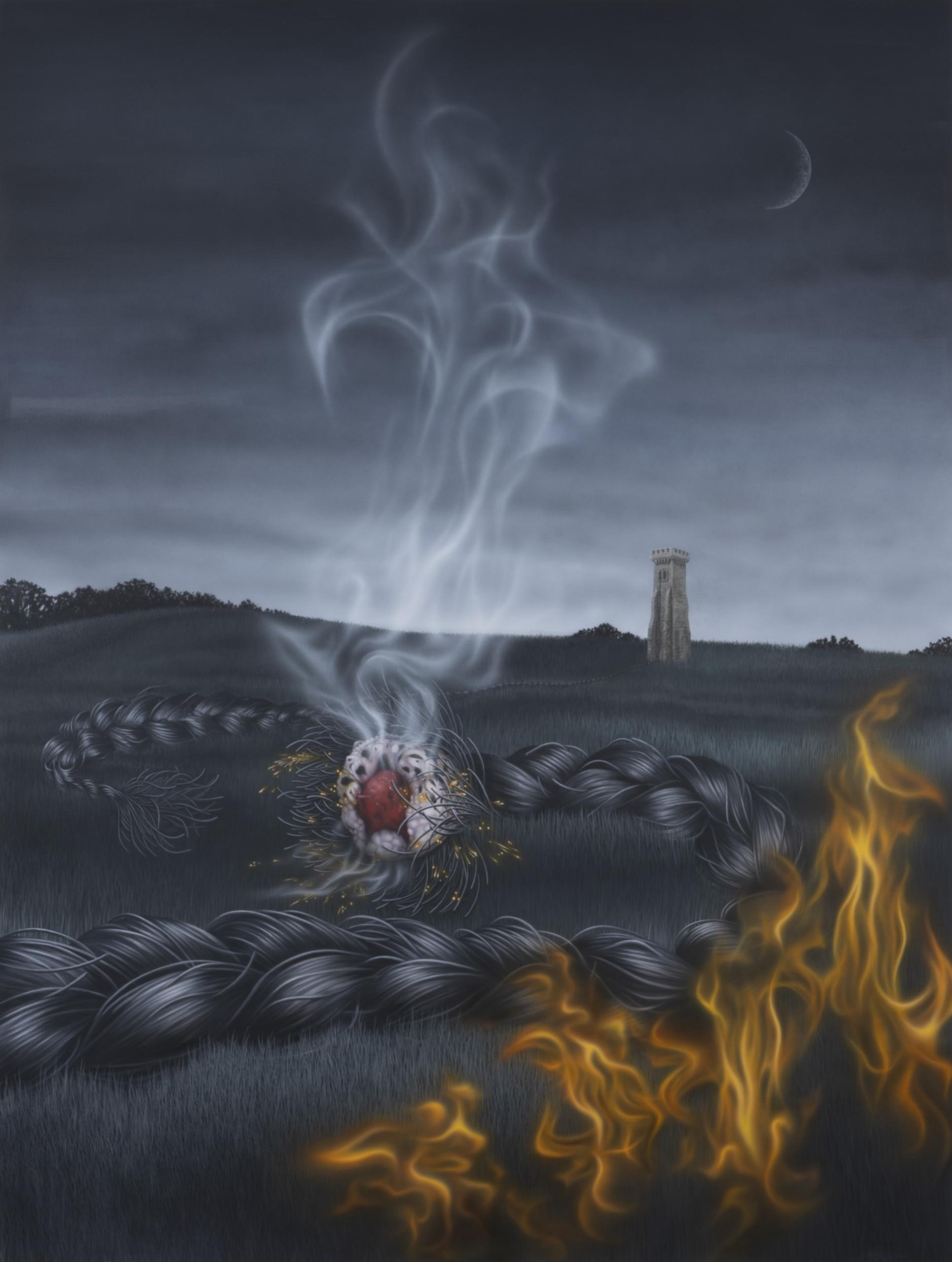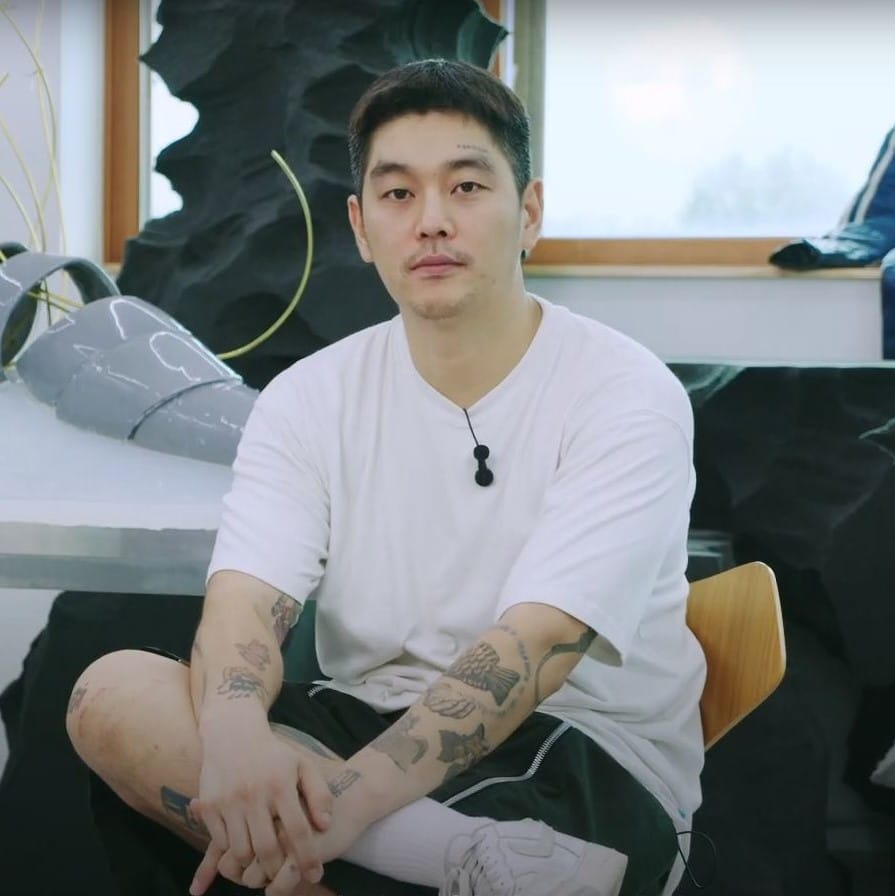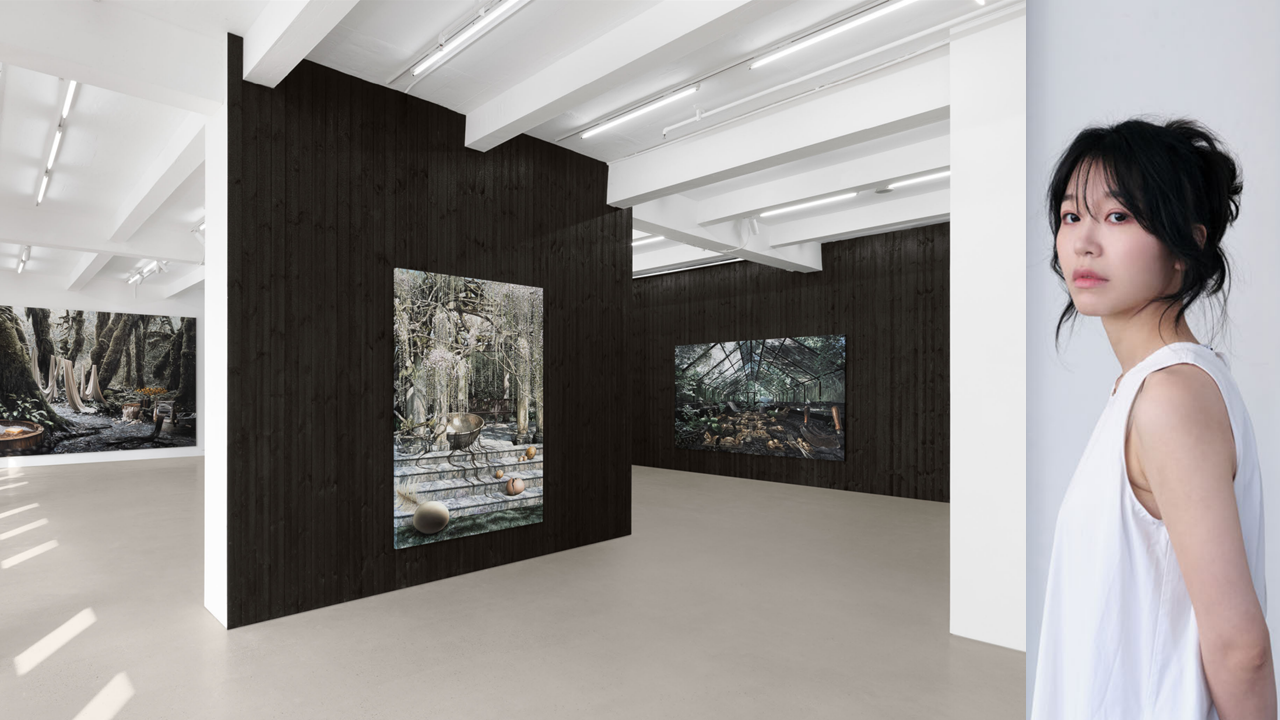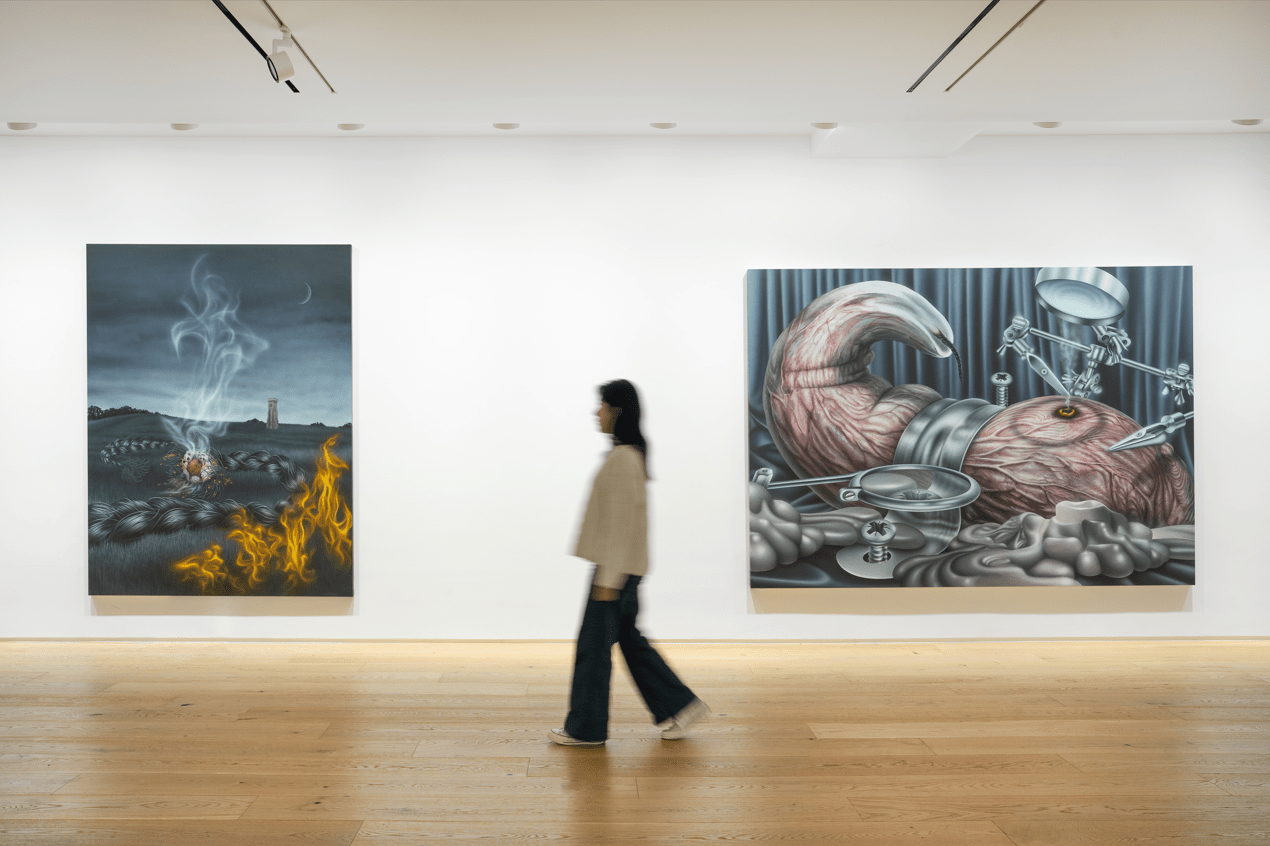
Partial exhibition view of “Myths of Our Time,” Thaddaeus Ropac gallery, Seoul. (January 6 – February 25, 2023). Courtesy Thaddaeus Ropac gallery, London • Paris • Salzburg • Seoul. Photo: artifacts.
It has been a year and a half since Thaddaeus Ropac, an Austria-based global mega-gallery with branches in London, Paris, and Salzburg, opened its first Asia outpost in Hannam-dong in October 2021.
The founder and owner of the gallery, Thaddaeus Ropac, who visited Korea, mentioned that the time had come for the gallery to introduce artists active in the Korean art world. Myths of Our Time, the first exhibition of 2023, introduces fifteen new works by three young female artists of Korean and Korean descent, running until February 25.
The fact that various overseas galleries are opening branches in Korea demonstrates that the Korean art market is appealing to the global art world; for overseas galleries, this indicates that the Korean art market and its neighboring art markets have significant buying power, and it is also a new stage for artists to expand their reach. This also increases the opportunities for local collectors to learn about artists outside the country and experience the global art trend.
Undoubtedly, this is a positive change for the local art world, but it is also important to examine whether the Korean art scene enjoys similar opportunities. Most of the artists that these mega-international galleries introduce to Korea are those who are renowned on the international stage. This can narrow the position of local artists and the art world in the local art community. Therefore, the Korean art world will need to evaluate whether these international galleries can continue to introduce various arts while simultaneously providing new impetus to the Korean art world so that local and overseas artists and galleries can coexist and develop together.
 Partial exhibition view of “Myths of Our Time,” Thaddaeus Ropac gallery, Seoul. (January 6 – February 25, 2023). Courtesy Thaddaeus Ropac gallery, London • Paris • Salzburg • Seoul. Photo: artifacts.
Partial exhibition view of “Myths of Our Time,” Thaddaeus Ropac gallery, Seoul. (January 6 – February 25, 2023). Courtesy Thaddaeus Ropac gallery, London • Paris • Salzburg • Seoul. Photo: artifacts.Myths of Our Times at Thaddaeus Ropac Seoul reflects the gallery’s concerns about this issue. When opening a new gallery in a new region, Ropac explained that he believes it is essential to introduce and collaborate with local artists. Executive Director of the gallery Kyu Jin Hwang also added, “We have been introducing artists whom our gallery represents to Korea until now, but this time we intend to introduce Korean artists to the global art world.”
Among the fifty artist studio visits, the Seoul gallery team considered the works of artists who not only use an artistic language that resonates with the global art world but who also incorporate Korean characteristics into their artworks. The three artists—Heemin Chung, Sun Woo, and Zadie Xa—have very different working methods and perspectives, but they share a common interest in mythology, presenting works that shed light on today’s technology-based society through mythical motifs.
 Heemin Chung, '먼 곳에서의 부름 (Distant Calling),' 2022, Acrylic, oil, inkjet transferred gel medium on canvas, 223 x 190 cm. Courtesy Thaddaeus Ropac gallery, London • Paris • Salzburg • Seoul. Photo: artifacts © the artist.
Heemin Chung, '먼 곳에서의 부름 (Distant Calling),' 2022, Acrylic, oil, inkjet transferred gel medium on canvas, 223 x 190 cm. Courtesy Thaddaeus Ropac gallery, London • Paris • Salzburg • Seoul. Photo: artifacts © the artist.Artist Heemin Chung creates images using digital modeling software and transfers them to paintings. However, her works are more tactile than flat. The unusual texture on the canvas accentuates the tactile characteristics of the surface of the artwork.
As everything becomes digitalized in the present day, Chung believes that the way we perceive and relate to things is gradually changing. Chung transfers the images produced in the digital environment, our experiences that are altered by those images, and the characteristics of these images onto the canvas. And to reflect on these changing experiences, she deviates from the conventional painting method, studies new materials and methods to create works that are three-dimensional and tactile, and creates paintings that question and explore the identity and emotion we have in modern society, as well as the significance of media and images.
 Installation view of Heemin Chung’s artworks, “Myths of Our Time,” Thaddaeus Ropac gallery, Seoul. (January 6 – February 25, 2023). Courtesy Thaddaeus Ropac gallery, London • Paris • Salzburg • Seoul Photo: artifacts.
Installation view of Heemin Chung’s artworks, “Myths of Our Time,” Thaddaeus Ropac gallery, Seoul. (January 6 – February 25, 2023). Courtesy Thaddaeus Ropac gallery, London • Paris • Salzburg • Seoul Photo: artifacts.Three new paintings and three sculptures inspired by the Roman fairy Echo are on display at Thaddaeus Ropac. For Heemin Chung, Echo, a nymph who could only repeat the sounds and last words of others, symbolizes the language ability of today’s people who live in the digital ecosystem, particularly in the digital circulation of information.
Painting is the art form that, according to the artist, best captures not only how people perceive the times but also how they change. Therefore, the artist’s sculptural works are also an extension of her painting experiments. Similar to other paintings, the sculptural pieces implemented in digital software remind us of the structure of a living body. Chung expresses the transformation of Echo’s body in the same way that Echo’s unrequited love for Narcissus caused her to gradually weaken and shrink, with her bones eventually turning to stone, leaving only her voice.

Heemin Chung. Courtesy Thaddaeus Ropac gallery, London • Paris • Salzburg • Seoul. Photo: W Korea
Born and based in Korea, artist Heemin Chung (b. 1987) held solo exhibitions at P21 and Sindoh Art Space in 2022 in Seoul. Chung won the 13th Doosan Yonkang Art Award in 2022 and is currently participating in the 22nd SongEun Art Awards Exhibition.
 Sun Woo, 'In the Cage,' 2022, Acrylic and charcoal on canvas, 220 x 166 cm. Courtesy Thaddaeus Ropac gallery, London • Paris • Salzburg • Seoul. Photo: artifacts. © the artist.
Sun Woo, 'In the Cage,' 2022, Acrylic and charcoal on canvas, 220 x 166 cm. Courtesy Thaddaeus Ropac gallery, London • Paris • Salzburg • Seoul. Photo: artifacts. © the artist.Artist Sun Woo, who has used Photoshop since childhood, creates digital collages and sketches using image editing software and transfers them to canvas. In this way, she creates paintings with a surreal yet dystopian sentiment. For example, her work In the Cage (2022) reminds us of a newly interpreted fairy tale, Rapunzel. Rapunzel’s hair is her only link to the outside world while she is imprisoned in a tower. The image of the painting metaphorically represents the contradictory situation of openness and closure in the digital society.
The artist utilizes digital software and mixes traditional painting techniques with new materials, such as airbrushes, to fuse images of machines and metal pieces with images of organic objects, such as body parts. For the artist, the deformed body parts are like various image fragments floating in the digital world; they are like living debris or a disconnected body in a fragmented and vulnerable state.
 Installation view of Sun Woo’s artworks, “Myths of Our Time,” Thaddaeus Ropac gallery, Seoul. (January 6 – February 25, 2023). Courtesy Thaddaeus Ropac gallery, London • Paris • Salzburg • Seoul. Photo: artifacts.
Installation view of Sun Woo’s artworks, “Myths of Our Time,” Thaddaeus Ropac gallery, Seoul. (January 6 – February 25, 2023). Courtesy Thaddaeus Ropac gallery, London • Paris • Salzburg • Seoul. Photo: artifacts.The images of fragile organs that are susceptible to deformation are placed alongside images of medieval armor or metal parts to emphasize the contrasting characteristics between the two objects. The artist depicts the image of metal pieces smoothly with an airbrush as if seen on a device screen and stresses the painterly and textural features of the body parts through hand painting. The artist’s intention in combining two different images is to show the fragility of the human body as well as the difference between the virtual and physical worlds and how technological advancements have altered our senses.
The artist collects various widely-consumed images today, such as objects, memes, and fandom culture. She separates these images from their original context, then alters the composition, color, and angle before recombining them on a single screen. The artist brings not only contemporary images but also objects that reflect the desires of past societies, such as amulets and jangseung (Korean traditional totem poles at the village entrance), and reassembles them based on the artist’s imagination of how they have been transformed and continued to this day, linking them to the artist’s personal thoughts. In this process, the artist also incorporates images from traditional Korean fairy tales and myths from other cultures, creating a new narrative.
 Sun Woo. Courtesy Thaddaeus Ropac gallery, London • Paris • Salzburg • Seoul. Photo: Sehui Hong
Sun Woo. Courtesy Thaddaeus Ropac gallery, London • Paris • Salzburg • Seoul. Photo: Sehui HongSun Woo (b. 1994) was born in Korea, grew up in Canada, and is currently based in Seoul. In 2021, she held her first solo exhibition at the Foundwill Art Society (FAS) in Seoul and another at the WOAW Gallery in Hong Kong.
 Zadie Xa, 'Kitchen Rituals & Lucky Red Petals,' 2022, Recycled leather, and assorted shell buttons on hand- sewn and machine-stitched linen, denim and mixed technical fabrics, 110 x 100 cm. Courtesy Thaddaeus Ropac gallery, London • Paris • Salzburg • Seoul. Photo: artifacts. © the artist.
Zadie Xa, 'Kitchen Rituals & Lucky Red Petals,' 2022, Recycled leather, and assorted shell buttons on hand- sewn and machine-stitched linen, denim and mixed technical fabrics, 110 x 100 cm. Courtesy Thaddaeus Ropac gallery, London • Paris • Salzburg • Seoul. Photo: artifacts. © the artist.The images and motifs in Zadie Xa’s new works are more reminiscent of traditional Korean myths than those of the other two artists. Xa, who is presenting her works in Korea for the first time, is interested in diasporic identity, history, folk culture, the spiritual world, and religious rituals such as ancestral rites. With a focus on painting, she creates works that combine various genres, such as sculpture, textile, sound, and performance.
As a Korean-Canadian, Xa grew up in a multicultural country and has worked in Spain and now England. She did not have the opportunity to deeply experience Korean culture, but she found her identity in Korean folktales such as “Mago Halmi” and “Baridegi,” which she heard from her mother and grandmother. In her works, Xa combines various images and symbols from traditional Korean mythology with personal stories to create a new myth that is very personal, Korean, and, at the same time, multicultural.
 Installation view of Zadie Xa’s artworks, “Myths of Our Time,” Thaddaeus Ropac gallery, Seoul. (January 6 – February 25, 2023). Courtesy Thaddaeus Ropac gallery, London • Paris • Salzburg • Seoul. Photo: artifacts.
Installation view of Zadie Xa’s artworks, “Myths of Our Time,” Thaddaeus Ropac gallery, Seoul. (January 6 – February 25, 2023). Courtesy Thaddaeus Ropac gallery, London • Paris • Salzburg • Seoul. Photo: artifacts.In addition to diasporic identity and diversity, the artist attempts to reveal narratives that have been deleted and suppressed by the West and occupying powers and examines socio-political conditions and cultural behavior through performance, costumes, and storytelling.
In Myths of Our Times, Xa presents works that incorporate handcrafted elements by using the quilting technique of bojagi. From the standpoint of an outsider unfamiliar with Korean culture, Xa’s textile work might be associated with Mondrian’s artwork. Nonetheless, the artist draws inspiration from anonymous or underrepresented artists and craftsmen rather than from masters who are prominent in art history. Xa re-illuminates the hidden artisans and female artists who were experts at creating supplementary works and attempts to create a new art historical framework by connecting herself with these artists.
 Zadie Xa, Courtesy Thaddaeus Ropac gallery, London • Paris • Salzburg • Seoul. © the artist
Zadie Xa, Courtesy Thaddaeus Ropac gallery, London • Paris • Salzburg • Seoul. © the artistCurrently based in England, Zadie Xa (b. 1983) is concurrently presenting a solo exhibition at the Whitechapel Gallery until April 30, 2023. The London exhibition coincides with Myths of Our Time at Thaddaeus Ropac Seoul. Xa’s works are also on display at the Jeju Biennale: Flowing Moon, Embracing Land. The artist also participated in the 58th Venice Biennale in 2019.
































